A Literature Review on the Effects and Impact of Assessments
VerifiedAdded on 2020/01/06
|15
|3620
|117
Report
AI Summary
This report presents a literature review on formative and summative assessments, exploring their definitions, differences, and impacts on student learning and teaching practices. It examines the objectives of the assessments, comparing strategies, and analyzing the effects of both assessment types. The review investigates the perspectives of students, teachers, and parents on the effectiveness of formative and summative assessments, highlighting the importance of formative assessments in identifying areas for improvement and the role of summative assessments in evaluating overall performance. The report also discusses the purpose and use of both assessment types, providing examples and strategies for their implementation. It concludes with recommendations for future research and emphasizes the need for a balanced approach to assessment to enhance student learning and academic outcomes. The study investigates the impact of formative and summative assessments, referencing key scholarly works to provide a comprehensive overview of their effects.
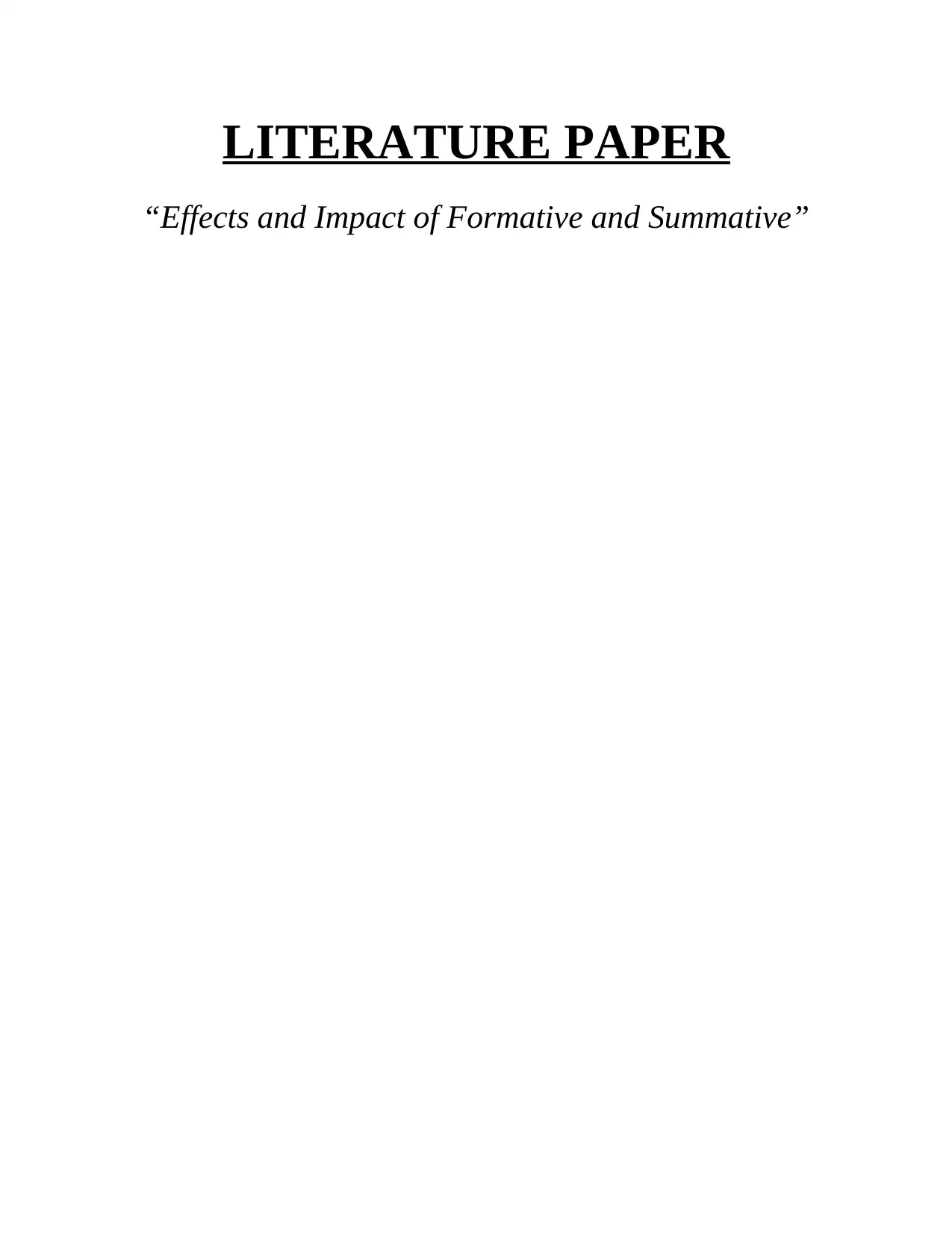
LITERATURE PAPER
“Effects and Impact of Formative and Summative”
“Effects and Impact of Formative and Summative”
Paraphrase This Document
Need a fresh take? Get an instant paraphrase of this document with our AI Paraphraser
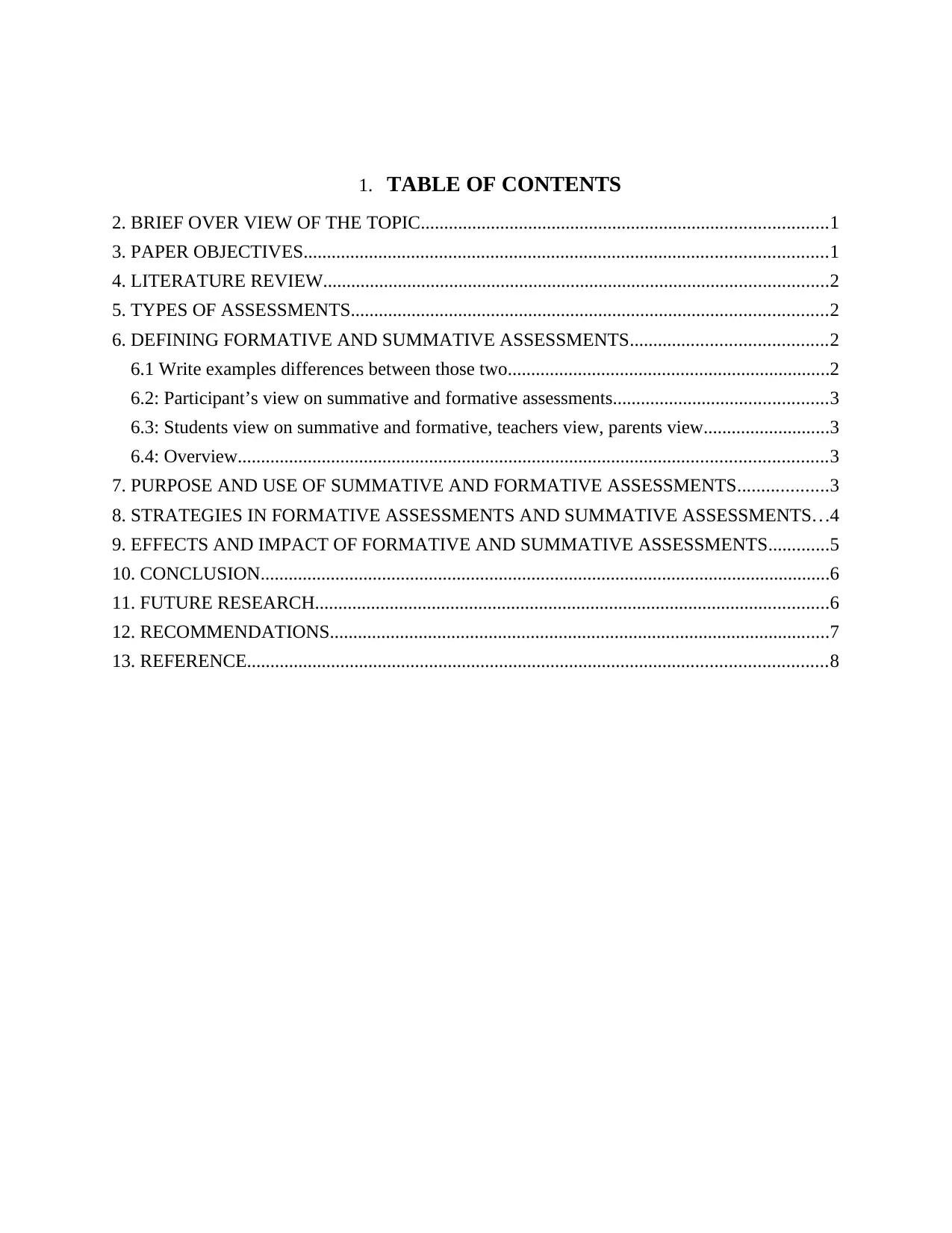
1. TABLE OF CONTENTS
2. BRIEF OVER VIEW OF THE TOPIC.......................................................................................1
3. PAPER OBJECTIVES................................................................................................................1
4. LITERATURE REVIEW............................................................................................................2
5. TYPES OF ASSESSMENTS......................................................................................................2
6. DEFINING FORMATIVE AND SUMMATIVE ASSESSMENTS..........................................2
6.1 Write examples differences between those two.....................................................................2
6.2: Participant’s view on summative and formative assessments..............................................3
6.3: Students view on summative and formative, teachers view, parents view...........................3
6.4: Overview..............................................................................................................................3
7. PURPOSE AND USE OF SUMMATIVE AND FORMATIVE ASSESSMENTS...................3
8. STRATEGIES IN FORMATIVE ASSESSMENTS AND SUMMATIVE ASSESSMENTS...4
9. EFFECTS AND IMPACT OF FORMATIVE AND SUMMATIVE ASSESSMENTS.............5
10. CONCLUSION..........................................................................................................................6
11. FUTURE RESEARCH..............................................................................................................6
12. RECOMMENDATIONS...........................................................................................................7
13. REFERENCE............................................................................................................................8
2. BRIEF OVER VIEW OF THE TOPIC.......................................................................................1
3. PAPER OBJECTIVES................................................................................................................1
4. LITERATURE REVIEW............................................................................................................2
5. TYPES OF ASSESSMENTS......................................................................................................2
6. DEFINING FORMATIVE AND SUMMATIVE ASSESSMENTS..........................................2
6.1 Write examples differences between those two.....................................................................2
6.2: Participant’s view on summative and formative assessments..............................................3
6.3: Students view on summative and formative, teachers view, parents view...........................3
6.4: Overview..............................................................................................................................3
7. PURPOSE AND USE OF SUMMATIVE AND FORMATIVE ASSESSMENTS...................3
8. STRATEGIES IN FORMATIVE ASSESSMENTS AND SUMMATIVE ASSESSMENTS...4
9. EFFECTS AND IMPACT OF FORMATIVE AND SUMMATIVE ASSESSMENTS.............5
10. CONCLUSION..........................................................................................................................6
11. FUTURE RESEARCH..............................................................................................................6
12. RECOMMENDATIONS...........................................................................................................7
13. REFERENCE............................................................................................................................8
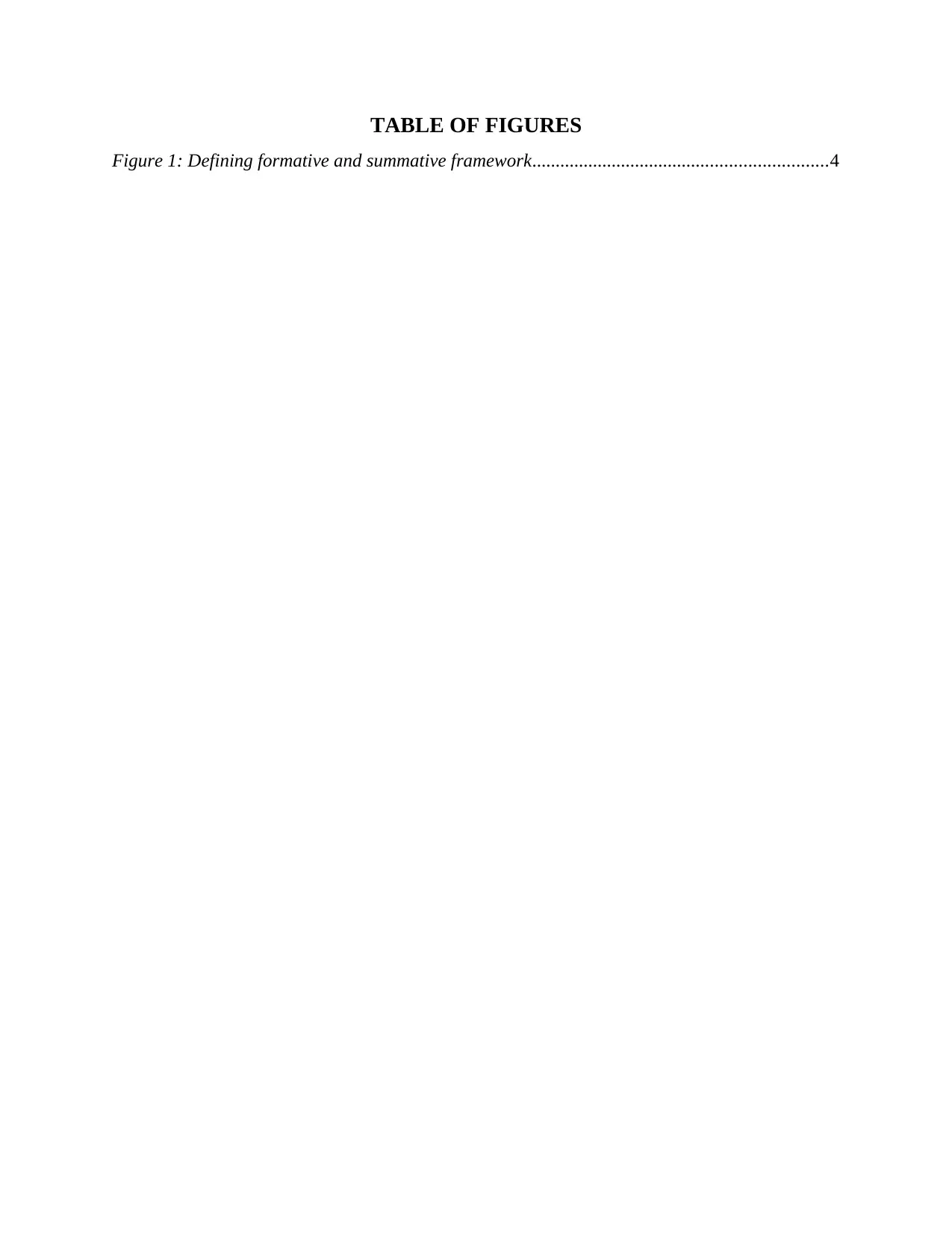
TABLE OF FIGURES
Figure 1: Defining formative and summative framework...............................................................4
Figure 1: Defining formative and summative framework...............................................................4
⊘ This is a preview!⊘
Do you want full access?
Subscribe today to unlock all pages.

Trusted by 1+ million students worldwide
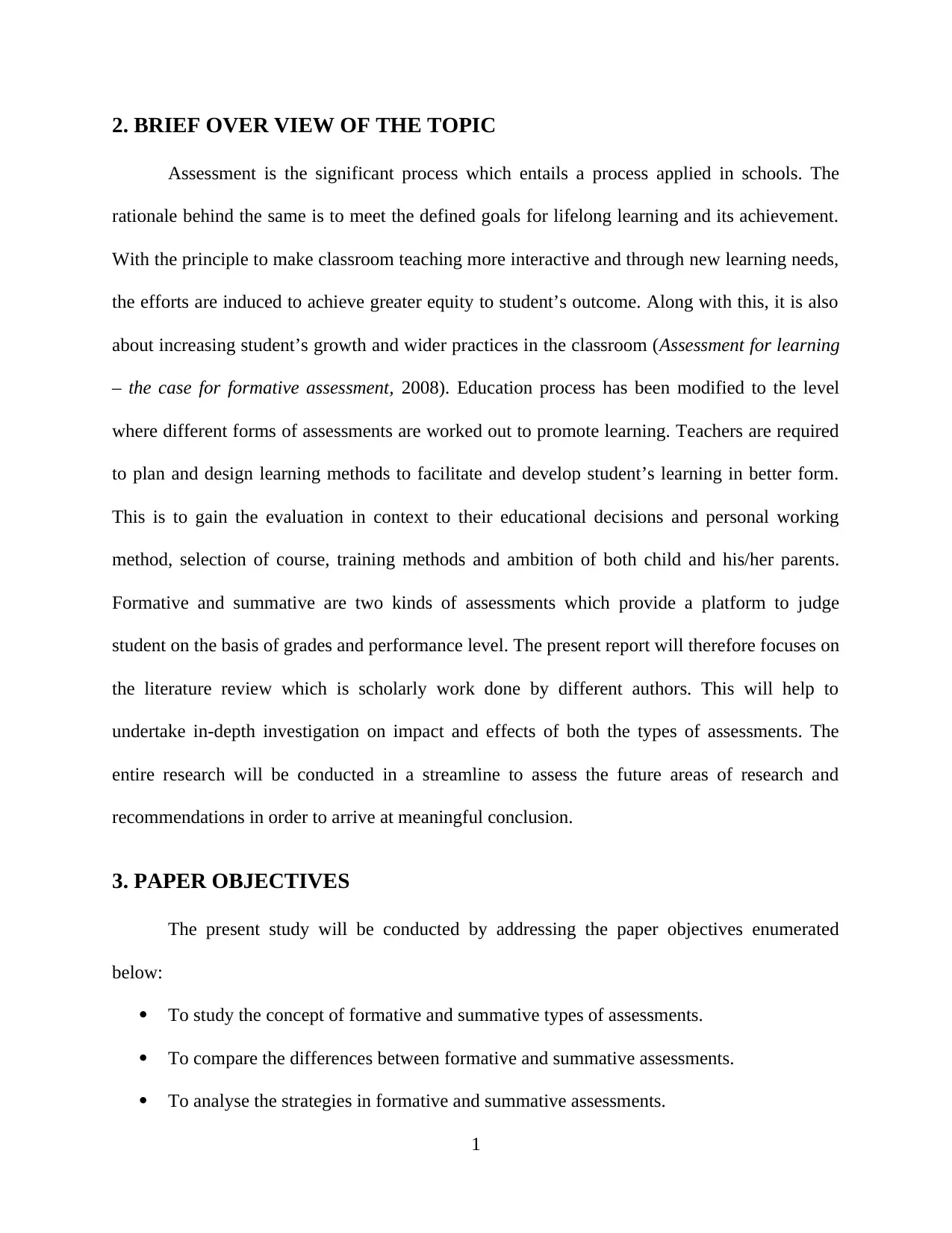
2. BRIEF OVER VIEW OF THE TOPIC
Assessment is the significant process which entails a process applied in schools. The
rationale behind the same is to meet the defined goals for lifelong learning and its achievement.
With the principle to make classroom teaching more interactive and through new learning needs,
the efforts are induced to achieve greater equity to student’s outcome. Along with this, it is also
about increasing student’s growth and wider practices in the classroom (Assessment for learning
– the case for formative assessment, 2008). Education process has been modified to the level
where different forms of assessments are worked out to promote learning. Teachers are required
to plan and design learning methods to facilitate and develop student’s learning in better form.
This is to gain the evaluation in context to their educational decisions and personal working
method, selection of course, training methods and ambition of both child and his/her parents.
Formative and summative are two kinds of assessments which provide a platform to judge
student on the basis of grades and performance level. The present report will therefore focuses on
the literature review which is scholarly work done by different authors. This will help to
undertake in-depth investigation on impact and effects of both the types of assessments. The
entire research will be conducted in a streamline to assess the future areas of research and
recommendations in order to arrive at meaningful conclusion.
3. PAPER OBJECTIVES
The present study will be conducted by addressing the paper objectives enumerated
below:
To study the concept of formative and summative types of assessments.
To compare the differences between formative and summative assessments.
To analyse the strategies in formative and summative assessments.
1
Assessment is the significant process which entails a process applied in schools. The
rationale behind the same is to meet the defined goals for lifelong learning and its achievement.
With the principle to make classroom teaching more interactive and through new learning needs,
the efforts are induced to achieve greater equity to student’s outcome. Along with this, it is also
about increasing student’s growth and wider practices in the classroom (Assessment for learning
– the case for formative assessment, 2008). Education process has been modified to the level
where different forms of assessments are worked out to promote learning. Teachers are required
to plan and design learning methods to facilitate and develop student’s learning in better form.
This is to gain the evaluation in context to their educational decisions and personal working
method, selection of course, training methods and ambition of both child and his/her parents.
Formative and summative are two kinds of assessments which provide a platform to judge
student on the basis of grades and performance level. The present report will therefore focuses on
the literature review which is scholarly work done by different authors. This will help to
undertake in-depth investigation on impact and effects of both the types of assessments. The
entire research will be conducted in a streamline to assess the future areas of research and
recommendations in order to arrive at meaningful conclusion.
3. PAPER OBJECTIVES
The present study will be conducted by addressing the paper objectives enumerated
below:
To study the concept of formative and summative types of assessments.
To compare the differences between formative and summative assessments.
To analyse the strategies in formative and summative assessments.
1
Paraphrase This Document
Need a fresh take? Get an instant paraphrase of this document with our AI Paraphraser
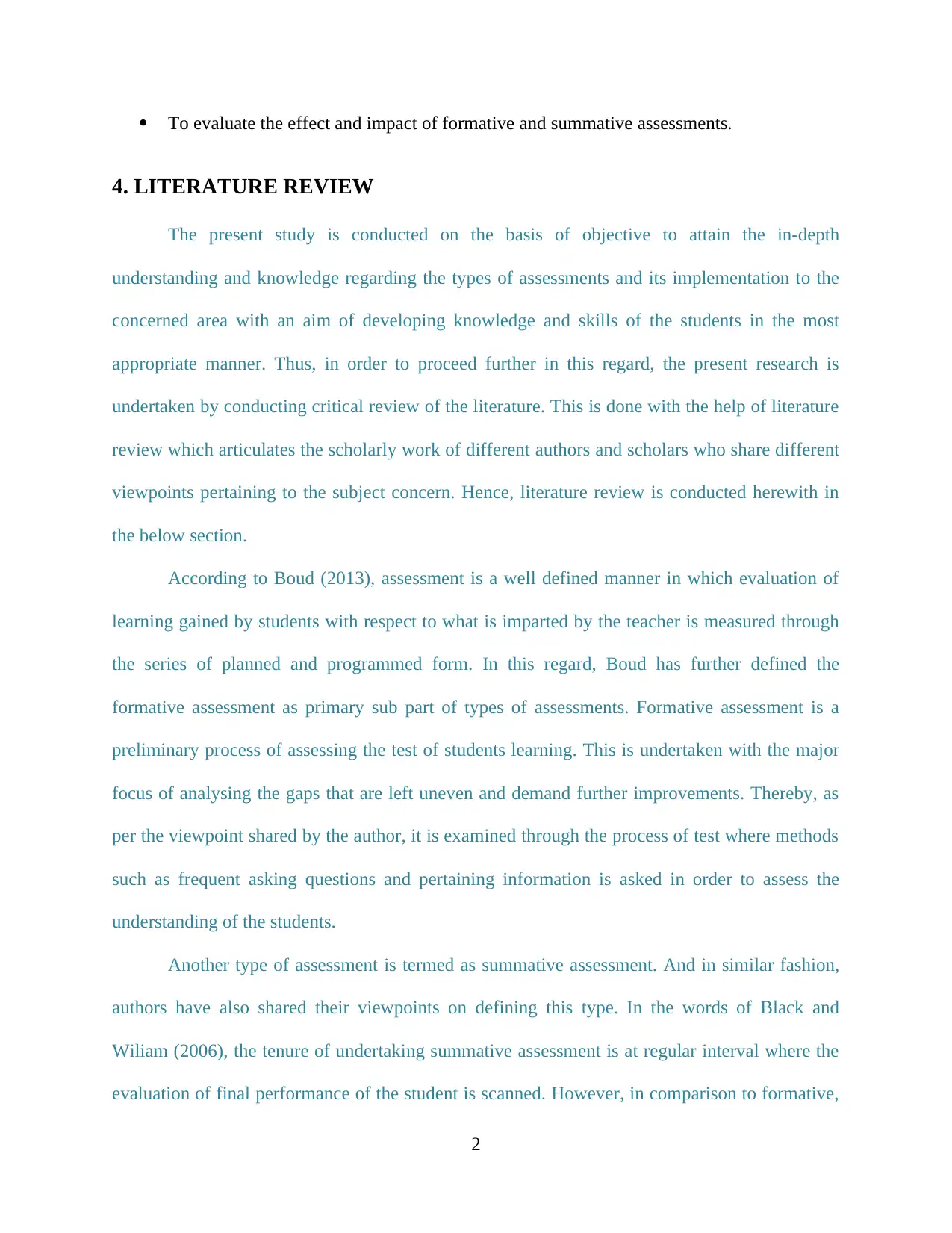
To evaluate the effect and impact of formative and summative assessments.
4. LITERATURE REVIEW
The present study is conducted on the basis of objective to attain the in-depth
understanding and knowledge regarding the types of assessments and its implementation to the
concerned area with an aim of developing knowledge and skills of the students in the most
appropriate manner. Thus, in order to proceed further in this regard, the present research is
undertaken by conducting critical review of the literature. This is done with the help of literature
review which articulates the scholarly work of different authors and scholars who share different
viewpoints pertaining to the subject concern. Hence, literature review is conducted herewith in
the below section.
According to Boud (2013), assessment is a well defined manner in which evaluation of
learning gained by students with respect to what is imparted by the teacher is measured through
the series of planned and programmed form. In this regard, Boud has further defined the
formative assessment as primary sub part of types of assessments. Formative assessment is a
preliminary process of assessing the test of students learning. This is undertaken with the major
focus of analysing the gaps that are left uneven and demand further improvements. Thereby, as
per the viewpoint shared by the author, it is examined through the process of test where methods
such as frequent asking questions and pertaining information is asked in order to assess the
understanding of the students.
Another type of assessment is termed as summative assessment. And in similar fashion,
authors have also shared their viewpoints on defining this type. In the words of Black and
Wiliam (2006), the tenure of undertaking summative assessment is at regular interval where the
evaluation of final performance of the student is scanned. However, in comparison to formative,
2
4. LITERATURE REVIEW
The present study is conducted on the basis of objective to attain the in-depth
understanding and knowledge regarding the types of assessments and its implementation to the
concerned area with an aim of developing knowledge and skills of the students in the most
appropriate manner. Thus, in order to proceed further in this regard, the present research is
undertaken by conducting critical review of the literature. This is done with the help of literature
review which articulates the scholarly work of different authors and scholars who share different
viewpoints pertaining to the subject concern. Hence, literature review is conducted herewith in
the below section.
According to Boud (2013), assessment is a well defined manner in which evaluation of
learning gained by students with respect to what is imparted by the teacher is measured through
the series of planned and programmed form. In this regard, Boud has further defined the
formative assessment as primary sub part of types of assessments. Formative assessment is a
preliminary process of assessing the test of students learning. This is undertaken with the major
focus of analysing the gaps that are left uneven and demand further improvements. Thereby, as
per the viewpoint shared by the author, it is examined through the process of test where methods
such as frequent asking questions and pertaining information is asked in order to assess the
understanding of the students.
Another type of assessment is termed as summative assessment. And in similar fashion,
authors have also shared their viewpoints on defining this type. In the words of Black and
Wiliam (2006), the tenure of undertaking summative assessment is at regular interval where the
evaluation of final performance of the student is scanned. However, in comparison to formative,
2
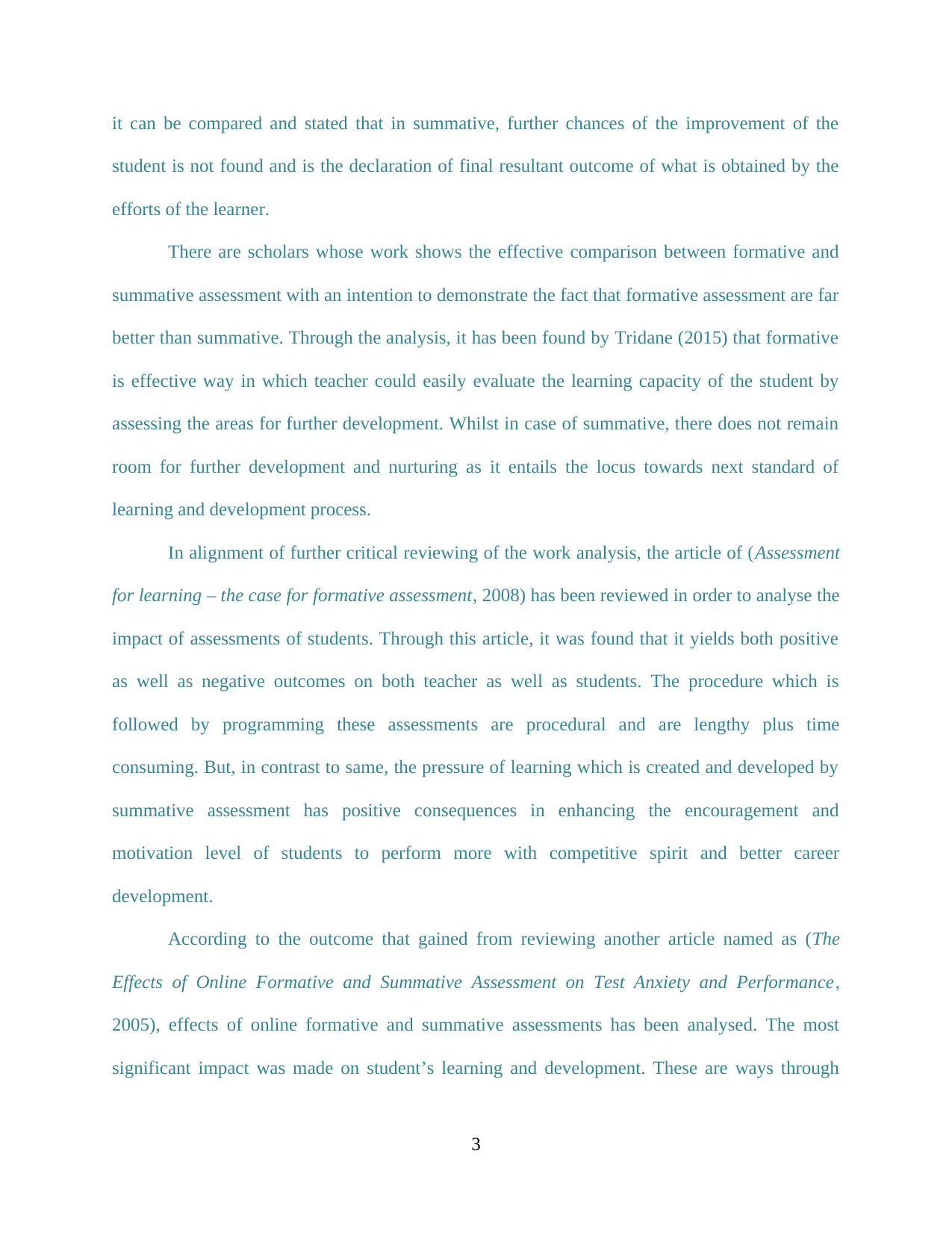
it can be compared and stated that in summative, further chances of the improvement of the
student is not found and is the declaration of final resultant outcome of what is obtained by the
efforts of the learner.
There are scholars whose work shows the effective comparison between formative and
summative assessment with an intention to demonstrate the fact that formative assessment are far
better than summative. Through the analysis, it has been found by Tridane (2015) that formative
is effective way in which teacher could easily evaluate the learning capacity of the student by
assessing the areas for further development. Whilst in case of summative, there does not remain
room for further development and nurturing as it entails the locus towards next standard of
learning and development process.
In alignment of further critical reviewing of the work analysis, the article of (Assessment
for learning – the case for formative assessment, 2008) has been reviewed in order to analyse the
impact of assessments of students. Through this article, it was found that it yields both positive
as well as negative outcomes on both teacher as well as students. The procedure which is
followed by programming these assessments are procedural and are lengthy plus time
consuming. But, in contrast to same, the pressure of learning which is created and developed by
summative assessment has positive consequences in enhancing the encouragement and
motivation level of students to perform more with competitive spirit and better career
development.
According to the outcome that gained from reviewing another article named as (The
Effects of Online Formative and Summative Assessment on Test Anxiety and Performance,
2005), effects of online formative and summative assessments has been analysed. The most
significant impact was made on student’s learning and development. These are ways through
3
student is not found and is the declaration of final resultant outcome of what is obtained by the
efforts of the learner.
There are scholars whose work shows the effective comparison between formative and
summative assessment with an intention to demonstrate the fact that formative assessment are far
better than summative. Through the analysis, it has been found by Tridane (2015) that formative
is effective way in which teacher could easily evaluate the learning capacity of the student by
assessing the areas for further development. Whilst in case of summative, there does not remain
room for further development and nurturing as it entails the locus towards next standard of
learning and development process.
In alignment of further critical reviewing of the work analysis, the article of (Assessment
for learning – the case for formative assessment, 2008) has been reviewed in order to analyse the
impact of assessments of students. Through this article, it was found that it yields both positive
as well as negative outcomes on both teacher as well as students. The procedure which is
followed by programming these assessments are procedural and are lengthy plus time
consuming. But, in contrast to same, the pressure of learning which is created and developed by
summative assessment has positive consequences in enhancing the encouragement and
motivation level of students to perform more with competitive spirit and better career
development.
According to the outcome that gained from reviewing another article named as (The
Effects of Online Formative and Summative Assessment on Test Anxiety and Performance,
2005), effects of online formative and summative assessments has been analysed. The most
significant impact was made on student’s learning and development. These are ways through
3
⊘ This is a preview!⊘
Do you want full access?
Subscribe today to unlock all pages.

Trusted by 1+ million students worldwide
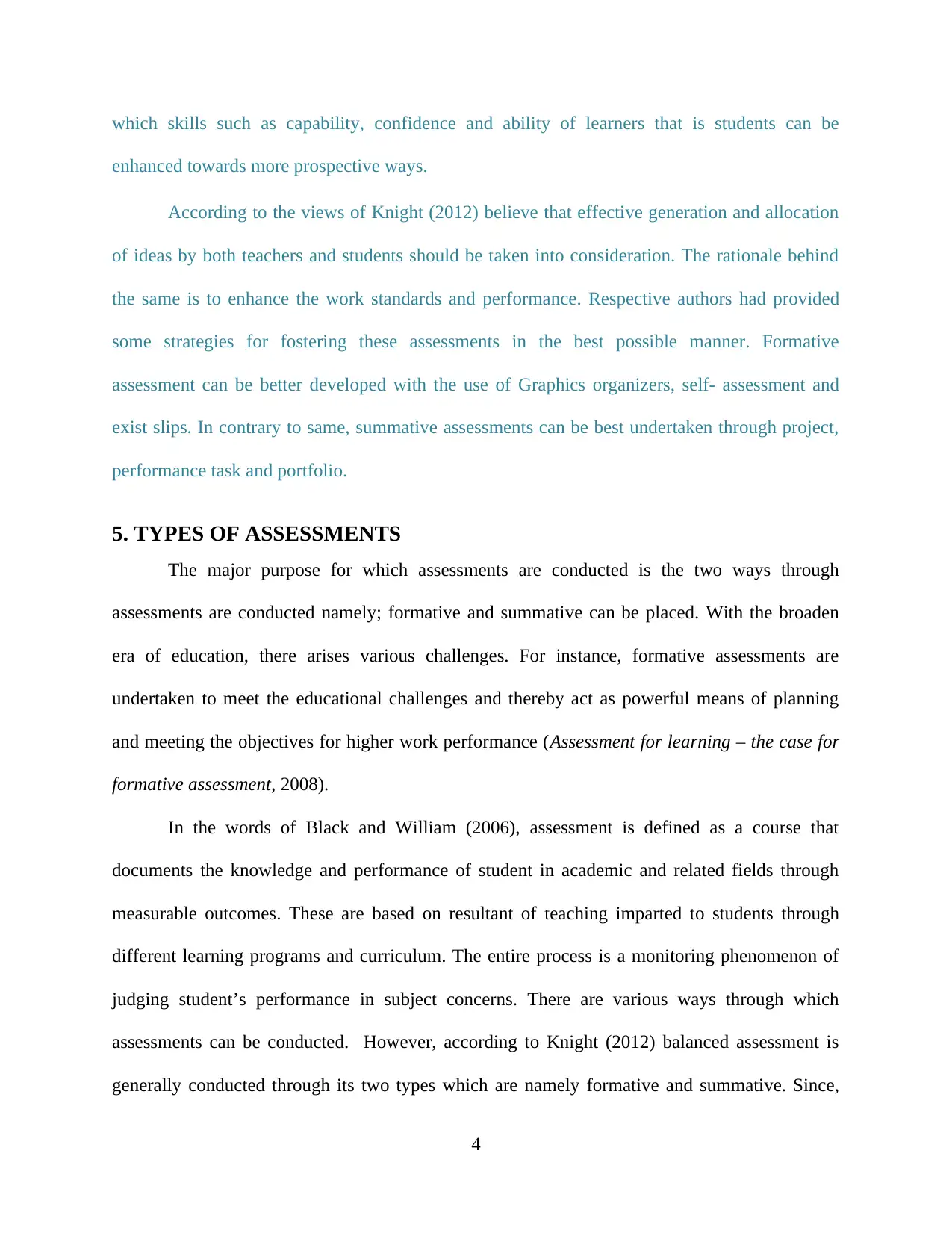
which skills such as capability, confidence and ability of learners that is students can be
enhanced towards more prospective ways.
According to the views of Knight (2012) believe that effective generation and allocation
of ideas by both teachers and students should be taken into consideration. The rationale behind
the same is to enhance the work standards and performance. Respective authors had provided
some strategies for fostering these assessments in the best possible manner. Formative
assessment can be better developed with the use of Graphics organizers, self- assessment and
exist slips. In contrary to same, summative assessments can be best undertaken through project,
performance task and portfolio.
5. TYPES OF ASSESSMENTS
The major purpose for which assessments are conducted is the two ways through
assessments are conducted namely; formative and summative can be placed. With the broaden
era of education, there arises various challenges. For instance, formative assessments are
undertaken to meet the educational challenges and thereby act as powerful means of planning
and meeting the objectives for higher work performance (Assessment for learning – the case for
formative assessment, 2008).
In the words of Black and William (2006), assessment is defined as a course that
documents the knowledge and performance of student in academic and related fields through
measurable outcomes. These are based on resultant of teaching imparted to students through
different learning programs and curriculum. The entire process is a monitoring phenomenon of
judging student’s performance in subject concerns. There are various ways through which
assessments can be conducted. However, according to Knight (2012) balanced assessment is
generally conducted through its two types which are namely formative and summative. Since,
4
enhanced towards more prospective ways.
According to the views of Knight (2012) believe that effective generation and allocation
of ideas by both teachers and students should be taken into consideration. The rationale behind
the same is to enhance the work standards and performance. Respective authors had provided
some strategies for fostering these assessments in the best possible manner. Formative
assessment can be better developed with the use of Graphics organizers, self- assessment and
exist slips. In contrary to same, summative assessments can be best undertaken through project,
performance task and portfolio.
5. TYPES OF ASSESSMENTS
The major purpose for which assessments are conducted is the two ways through
assessments are conducted namely; formative and summative can be placed. With the broaden
era of education, there arises various challenges. For instance, formative assessments are
undertaken to meet the educational challenges and thereby act as powerful means of planning
and meeting the objectives for higher work performance (Assessment for learning – the case for
formative assessment, 2008).
In the words of Black and William (2006), assessment is defined as a course that
documents the knowledge and performance of student in academic and related fields through
measurable outcomes. These are based on resultant of teaching imparted to students through
different learning programs and curriculum. The entire process is a monitoring phenomenon of
judging student’s performance in subject concerns. There are various ways through which
assessments can be conducted. However, according to Knight (2012) balanced assessment is
generally conducted through its two types which are namely formative and summative. Since,
4
Paraphrase This Document
Need a fresh take? Get an instant paraphrase of this document with our AI Paraphraser
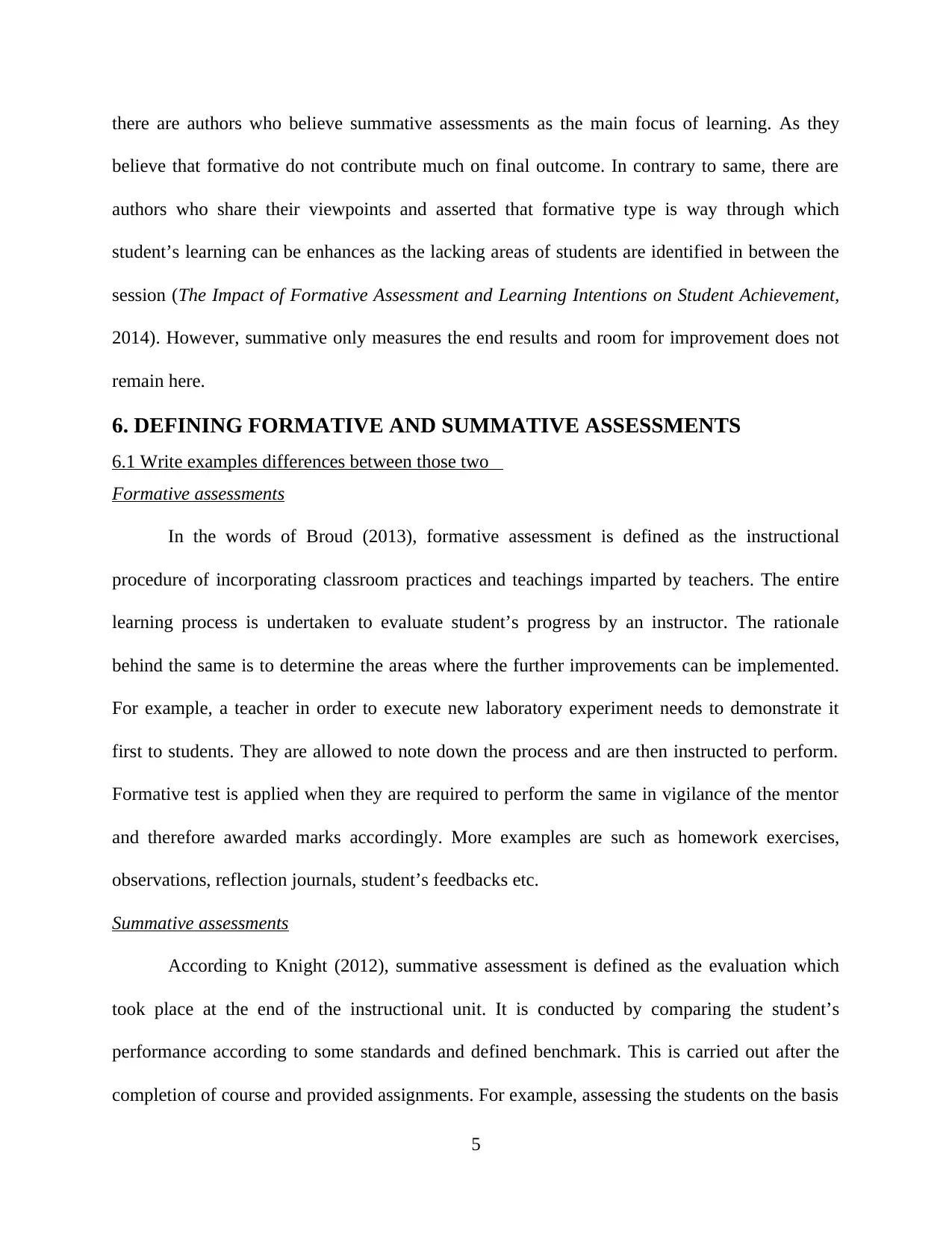
there are authors who believe summative assessments as the main focus of learning. As they
believe that formative do not contribute much on final outcome. In contrary to same, there are
authors who share their viewpoints and asserted that formative type is way through which
student’s learning can be enhances as the lacking areas of students are identified in between the
session (The Impact of Formative Assessment and Learning Intentions on Student Achievement,
2014). However, summative only measures the end results and room for improvement does not
remain here.
6. DEFINING FORMATIVE AND SUMMATIVE ASSESSMENTS
6.1 Write examples differences between those two
Formative assessments
In the words of Broud (2013), formative assessment is defined as the instructional
procedure of incorporating classroom practices and teachings imparted by teachers. The entire
learning process is undertaken to evaluate student’s progress by an instructor. The rationale
behind the same is to determine the areas where the further improvements can be implemented.
For example, a teacher in order to execute new laboratory experiment needs to demonstrate it
first to students. They are allowed to note down the process and are then instructed to perform.
Formative test is applied when they are required to perform the same in vigilance of the mentor
and therefore awarded marks accordingly. More examples are such as homework exercises,
observations, reflection journals, student’s feedbacks etc.
Summative assessments
According to Knight (2012), summative assessment is defined as the evaluation which
took place at the end of the instructional unit. It is conducted by comparing the student’s
performance according to some standards and defined benchmark. This is carried out after the
completion of course and provided assignments. For example, assessing the students on the basis
5
believe that formative do not contribute much on final outcome. In contrary to same, there are
authors who share their viewpoints and asserted that formative type is way through which
student’s learning can be enhances as the lacking areas of students are identified in between the
session (The Impact of Formative Assessment and Learning Intentions on Student Achievement,
2014). However, summative only measures the end results and room for improvement does not
remain here.
6. DEFINING FORMATIVE AND SUMMATIVE ASSESSMENTS
6.1 Write examples differences between those two
Formative assessments
In the words of Broud (2013), formative assessment is defined as the instructional
procedure of incorporating classroom practices and teachings imparted by teachers. The entire
learning process is undertaken to evaluate student’s progress by an instructor. The rationale
behind the same is to determine the areas where the further improvements can be implemented.
For example, a teacher in order to execute new laboratory experiment needs to demonstrate it
first to students. They are allowed to note down the process and are then instructed to perform.
Formative test is applied when they are required to perform the same in vigilance of the mentor
and therefore awarded marks accordingly. More examples are such as homework exercises,
observations, reflection journals, student’s feedbacks etc.
Summative assessments
According to Knight (2012), summative assessment is defined as the evaluation which
took place at the end of the instructional unit. It is conducted by comparing the student’s
performance according to some standards and defined benchmark. This is carried out after the
completion of course and provided assignments. For example, assessing the students on the basis
5
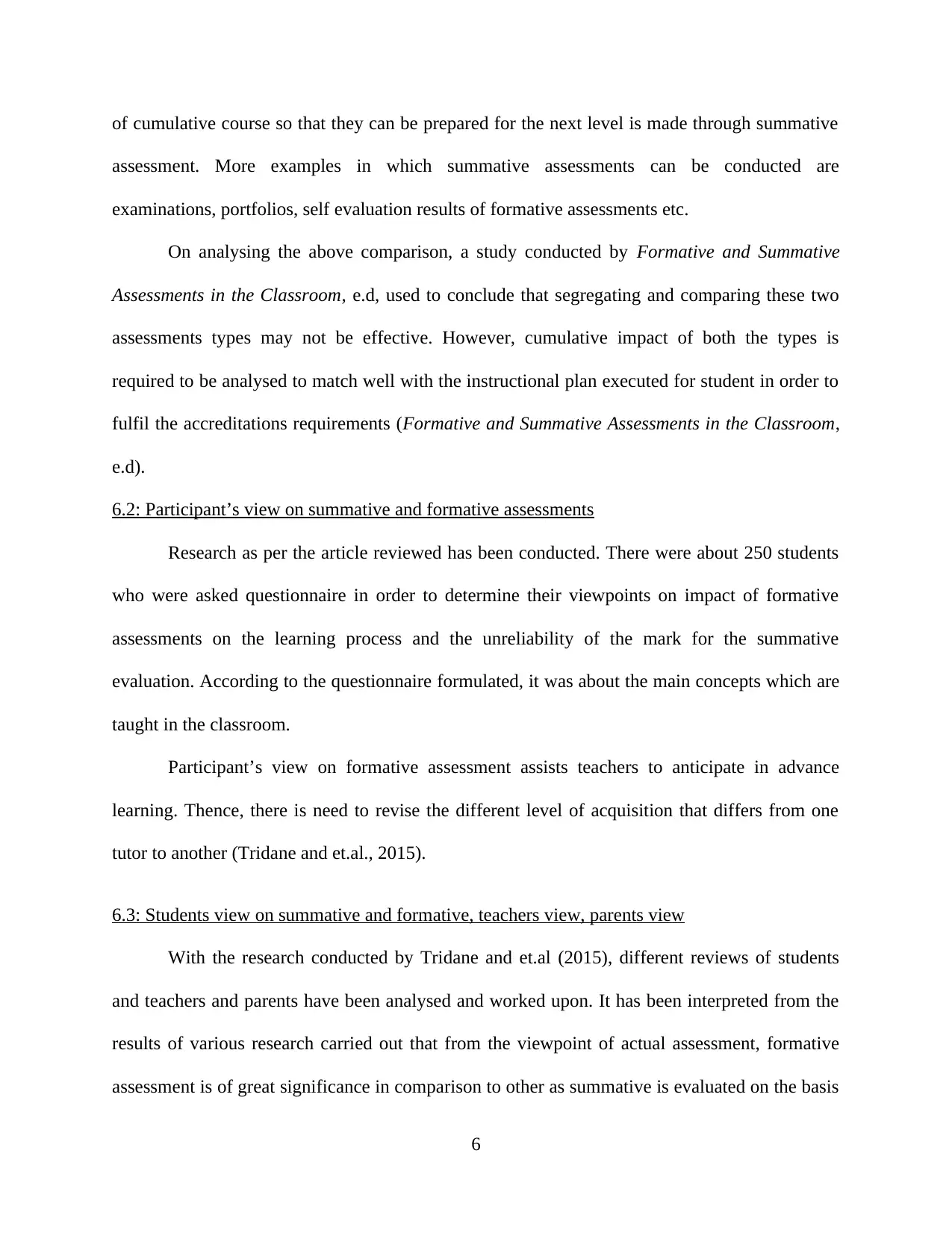
of cumulative course so that they can be prepared for the next level is made through summative
assessment. More examples in which summative assessments can be conducted are
examinations, portfolios, self evaluation results of formative assessments etc.
On analysing the above comparison, a study conducted by Formative and Summative
Assessments in the Classroom, e.d, used to conclude that segregating and comparing these two
assessments types may not be effective. However, cumulative impact of both the types is
required to be analysed to match well with the instructional plan executed for student in order to
fulfil the accreditations requirements (Formative and Summative Assessments in the Classroom,
e.d).
6.2: Participant’s view on summative and formative assessments
Research as per the article reviewed has been conducted. There were about 250 students
who were asked questionnaire in order to determine their viewpoints on impact of formative
assessments on the learning process and the unreliability of the mark for the summative
evaluation. According to the questionnaire formulated, it was about the main concepts which are
taught in the classroom.
Participant’s view on formative assessment assists teachers to anticipate in advance
learning. Thence, there is need to revise the different level of acquisition that differs from one
tutor to another (Tridane and et.al., 2015).
6.3: Students view on summative and formative, teachers view, parents view
With the research conducted by Tridane and et.al (2015), different reviews of students
and teachers and parents have been analysed and worked upon. It has been interpreted from the
results of various research carried out that from the viewpoint of actual assessment, formative
assessment is of great significance in comparison to other as summative is evaluated on the basis
6
assessment. More examples in which summative assessments can be conducted are
examinations, portfolios, self evaluation results of formative assessments etc.
On analysing the above comparison, a study conducted by Formative and Summative
Assessments in the Classroom, e.d, used to conclude that segregating and comparing these two
assessments types may not be effective. However, cumulative impact of both the types is
required to be analysed to match well with the instructional plan executed for student in order to
fulfil the accreditations requirements (Formative and Summative Assessments in the Classroom,
e.d).
6.2: Participant’s view on summative and formative assessments
Research as per the article reviewed has been conducted. There were about 250 students
who were asked questionnaire in order to determine their viewpoints on impact of formative
assessments on the learning process and the unreliability of the mark for the summative
evaluation. According to the questionnaire formulated, it was about the main concepts which are
taught in the classroom.
Participant’s view on formative assessment assists teachers to anticipate in advance
learning. Thence, there is need to revise the different level of acquisition that differs from one
tutor to another (Tridane and et.al., 2015).
6.3: Students view on summative and formative, teachers view, parents view
With the research conducted by Tridane and et.al (2015), different reviews of students
and teachers and parents have been analysed and worked upon. It has been interpreted from the
results of various research carried out that from the viewpoint of actual assessment, formative
assessment is of great significance in comparison to other as summative is evaluated on the basis
6
⊘ This is a preview!⊘
Do you want full access?
Subscribe today to unlock all pages.

Trusted by 1+ million students worldwide
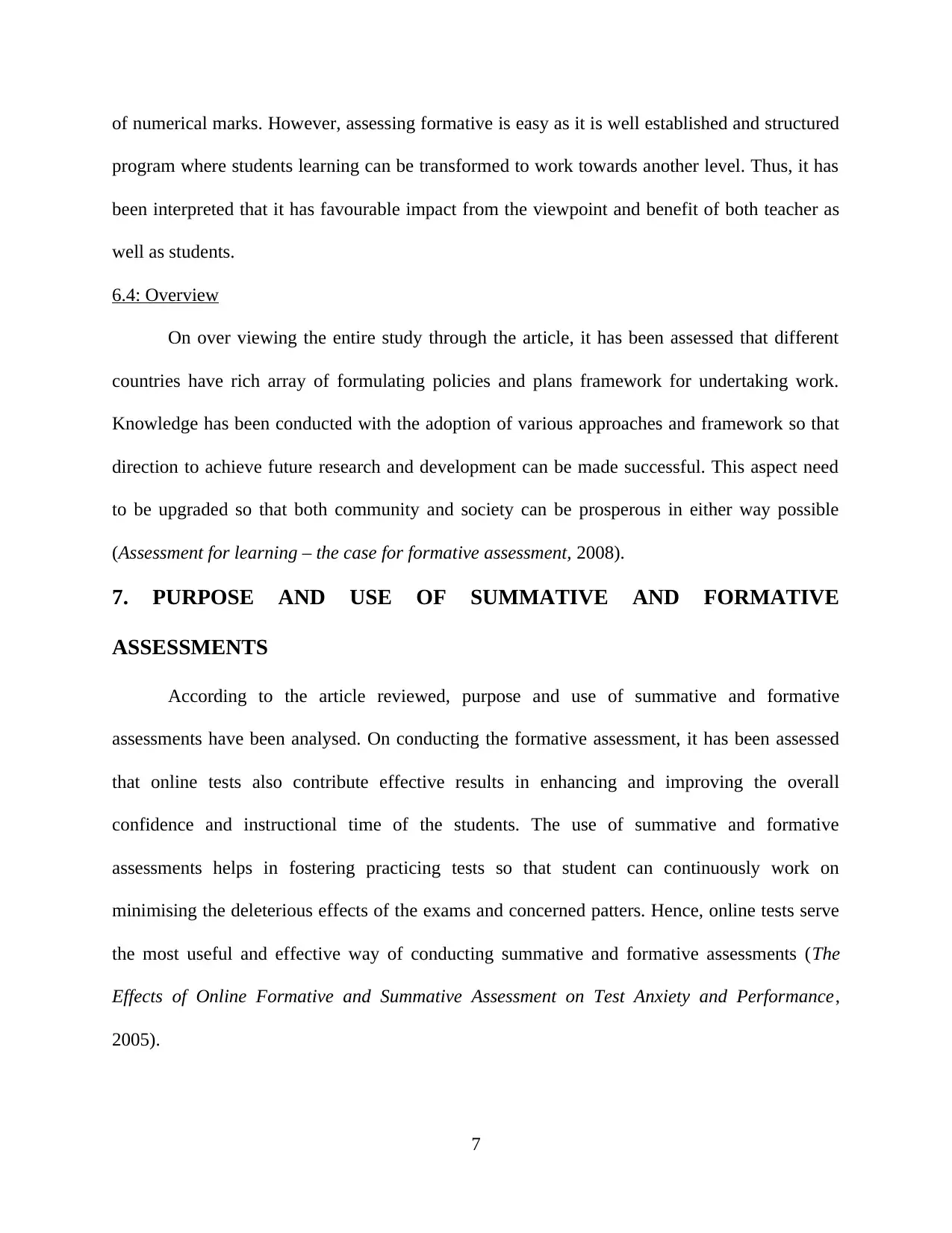
of numerical marks. However, assessing formative is easy as it is well established and structured
program where students learning can be transformed to work towards another level. Thus, it has
been interpreted that it has favourable impact from the viewpoint and benefit of both teacher as
well as students.
6.4: Overview
On over viewing the entire study through the article, it has been assessed that different
countries have rich array of formulating policies and plans framework for undertaking work.
Knowledge has been conducted with the adoption of various approaches and framework so that
direction to achieve future research and development can be made successful. This aspect need
to be upgraded so that both community and society can be prosperous in either way possible
(Assessment for learning – the case for formative assessment, 2008).
7. PURPOSE AND USE OF SUMMATIVE AND FORMATIVE
ASSESSMENTS
According to the article reviewed, purpose and use of summative and formative
assessments have been analysed. On conducting the formative assessment, it has been assessed
that online tests also contribute effective results in enhancing and improving the overall
confidence and instructional time of the students. The use of summative and formative
assessments helps in fostering practicing tests so that student can continuously work on
minimising the deleterious effects of the exams and concerned patters. Hence, online tests serve
the most useful and effective way of conducting summative and formative assessments (The
Effects of Online Formative and Summative Assessment on Test Anxiety and Performance,
2005).
7
program where students learning can be transformed to work towards another level. Thus, it has
been interpreted that it has favourable impact from the viewpoint and benefit of both teacher as
well as students.
6.4: Overview
On over viewing the entire study through the article, it has been assessed that different
countries have rich array of formulating policies and plans framework for undertaking work.
Knowledge has been conducted with the adoption of various approaches and framework so that
direction to achieve future research and development can be made successful. This aspect need
to be upgraded so that both community and society can be prosperous in either way possible
(Assessment for learning – the case for formative assessment, 2008).
7. PURPOSE AND USE OF SUMMATIVE AND FORMATIVE
ASSESSMENTS
According to the article reviewed, purpose and use of summative and formative
assessments have been analysed. On conducting the formative assessment, it has been assessed
that online tests also contribute effective results in enhancing and improving the overall
confidence and instructional time of the students. The use of summative and formative
assessments helps in fostering practicing tests so that student can continuously work on
minimising the deleterious effects of the exams and concerned patters. Hence, online tests serve
the most useful and effective way of conducting summative and formative assessments (The
Effects of Online Formative and Summative Assessment on Test Anxiety and Performance,
2005).
7
Paraphrase This Document
Need a fresh take? Get an instant paraphrase of this document with our AI Paraphraser
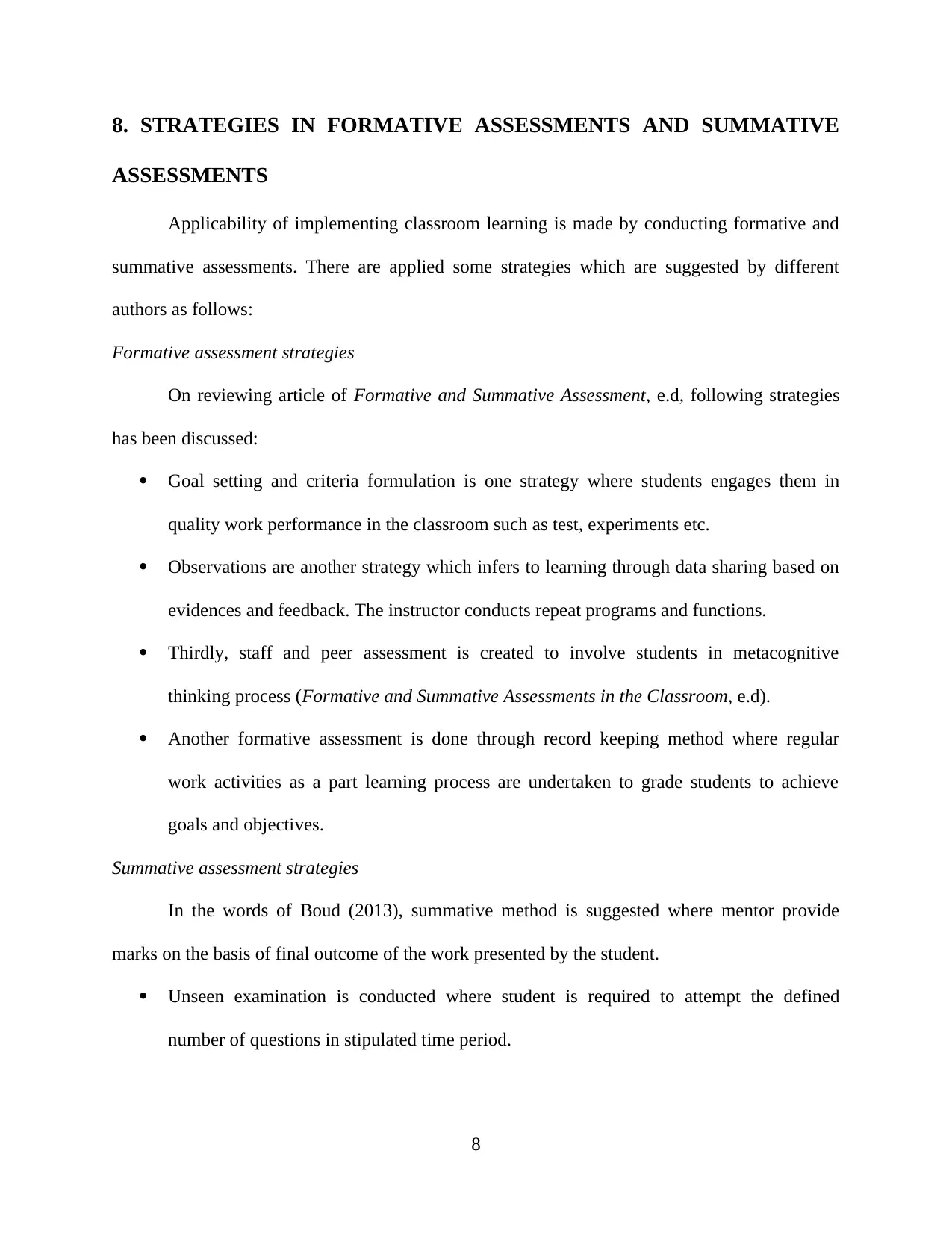
8. STRATEGIES IN FORMATIVE ASSESSMENTS AND SUMMATIVE
ASSESSMENTS
Applicability of implementing classroom learning is made by conducting formative and
summative assessments. There are applied some strategies which are suggested by different
authors as follows:
Formative assessment strategies
On reviewing article of Formative and Summative Assessment, e.d, following strategies
has been discussed:
Goal setting and criteria formulation is one strategy where students engages them in
quality work performance in the classroom such as test, experiments etc.
Observations are another strategy which infers to learning through data sharing based on
evidences and feedback. The instructor conducts repeat programs and functions.
Thirdly, staff and peer assessment is created to involve students in metacognitive
thinking process (Formative and Summative Assessments in the Classroom, e.d).
Another formative assessment is done through record keeping method where regular
work activities as a part learning process are undertaken to grade students to achieve
goals and objectives.
Summative assessment strategies
In the words of Boud (2013), summative method is suggested where mentor provide
marks on the basis of final outcome of the work presented by the student.
Unseen examination is conducted where student is required to attempt the defined
number of questions in stipulated time period.
8
ASSESSMENTS
Applicability of implementing classroom learning is made by conducting formative and
summative assessments. There are applied some strategies which are suggested by different
authors as follows:
Formative assessment strategies
On reviewing article of Formative and Summative Assessment, e.d, following strategies
has been discussed:
Goal setting and criteria formulation is one strategy where students engages them in
quality work performance in the classroom such as test, experiments etc.
Observations are another strategy which infers to learning through data sharing based on
evidences and feedback. The instructor conducts repeat programs and functions.
Thirdly, staff and peer assessment is created to involve students in metacognitive
thinking process (Formative and Summative Assessments in the Classroom, e.d).
Another formative assessment is done through record keeping method where regular
work activities as a part learning process are undertaken to grade students to achieve
goals and objectives.
Summative assessment strategies
In the words of Boud (2013), summative method is suggested where mentor provide
marks on the basis of final outcome of the work presented by the student.
Unseen examination is conducted where student is required to attempt the defined
number of questions in stipulated time period.
8
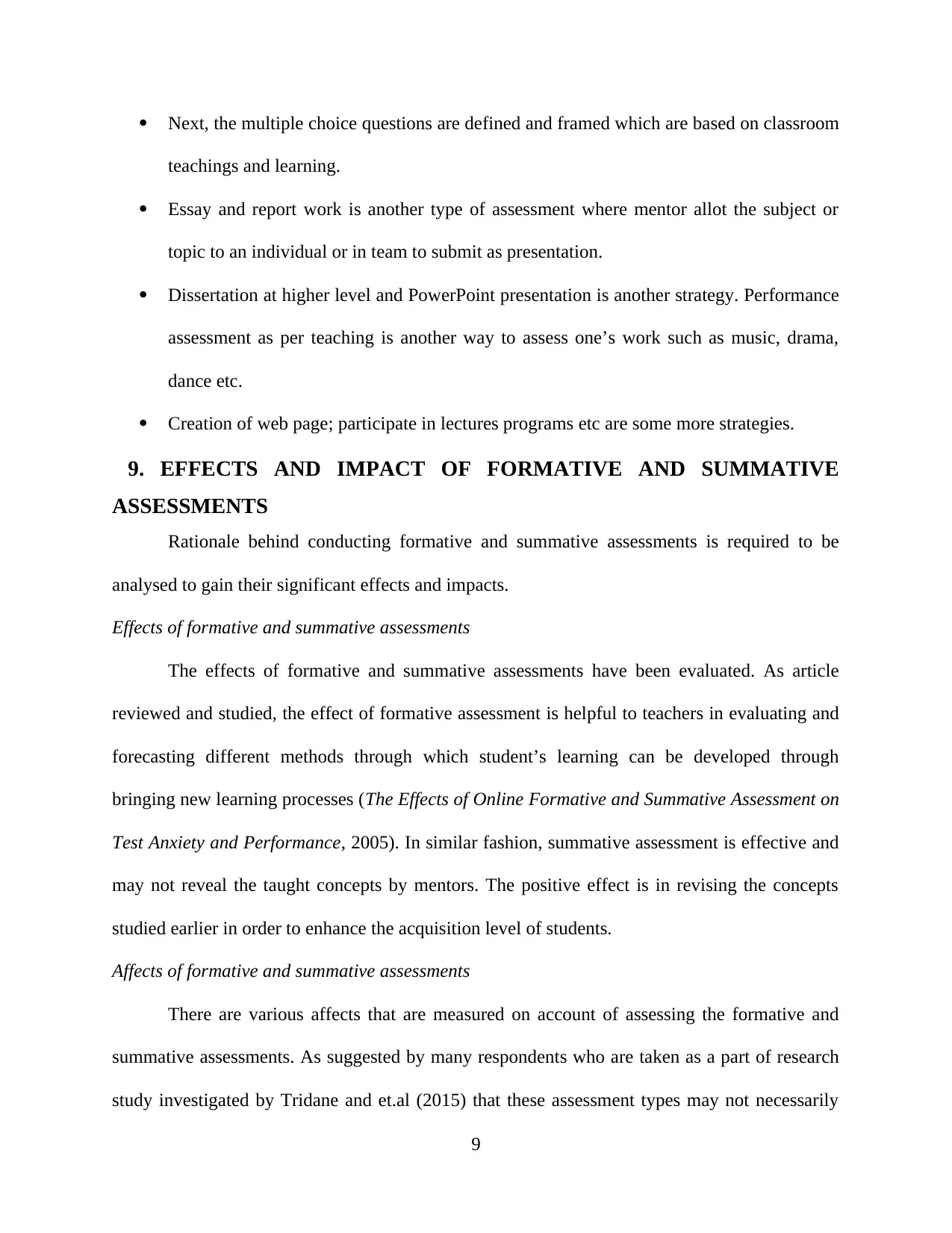
Next, the multiple choice questions are defined and framed which are based on classroom
teachings and learning.
Essay and report work is another type of assessment where mentor allot the subject or
topic to an individual or in team to submit as presentation.
Dissertation at higher level and PowerPoint presentation is another strategy. Performance
assessment as per teaching is another way to assess one’s work such as music, drama,
dance etc.
Creation of web page; participate in lectures programs etc are some more strategies.
9. EFFECTS AND IMPACT OF FORMATIVE AND SUMMATIVE
ASSESSMENTS
Rationale behind conducting formative and summative assessments is required to be
analysed to gain their significant effects and impacts.
Effects of formative and summative assessments
The effects of formative and summative assessments have been evaluated. As article
reviewed and studied, the effect of formative assessment is helpful to teachers in evaluating and
forecasting different methods through which student’s learning can be developed through
bringing new learning processes (The Effects of Online Formative and Summative Assessment on
Test Anxiety and Performance, 2005). In similar fashion, summative assessment is effective and
may not reveal the taught concepts by mentors. The positive effect is in revising the concepts
studied earlier in order to enhance the acquisition level of students.
Affects of formative and summative assessments
There are various affects that are measured on account of assessing the formative and
summative assessments. As suggested by many respondents who are taken as a part of research
study investigated by Tridane and et.al (2015) that these assessment types may not necessarily
9
teachings and learning.
Essay and report work is another type of assessment where mentor allot the subject or
topic to an individual or in team to submit as presentation.
Dissertation at higher level and PowerPoint presentation is another strategy. Performance
assessment as per teaching is another way to assess one’s work such as music, drama,
dance etc.
Creation of web page; participate in lectures programs etc are some more strategies.
9. EFFECTS AND IMPACT OF FORMATIVE AND SUMMATIVE
ASSESSMENTS
Rationale behind conducting formative and summative assessments is required to be
analysed to gain their significant effects and impacts.
Effects of formative and summative assessments
The effects of formative and summative assessments have been evaluated. As article
reviewed and studied, the effect of formative assessment is helpful to teachers in evaluating and
forecasting different methods through which student’s learning can be developed through
bringing new learning processes (The Effects of Online Formative and Summative Assessment on
Test Anxiety and Performance, 2005). In similar fashion, summative assessment is effective and
may not reveal the taught concepts by mentors. The positive effect is in revising the concepts
studied earlier in order to enhance the acquisition level of students.
Affects of formative and summative assessments
There are various affects that are measured on account of assessing the formative and
summative assessments. As suggested by many respondents who are taken as a part of research
study investigated by Tridane and et.al (2015) that these assessment types may not necessarily
9
⊘ This is a preview!⊘
Do you want full access?
Subscribe today to unlock all pages.

Trusted by 1+ million students worldwide
1 out of 15
Related Documents
Your All-in-One AI-Powered Toolkit for Academic Success.
+13062052269
info@desklib.com
Available 24*7 on WhatsApp / Email
![[object Object]](/_next/static/media/star-bottom.7253800d.svg)
Unlock your academic potential
Copyright © 2020–2025 A2Z Services. All Rights Reserved. Developed and managed by ZUCOL.





